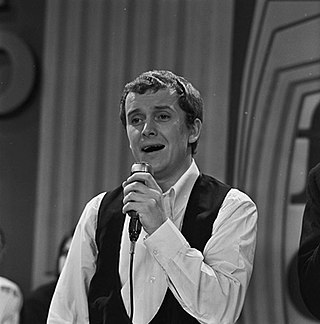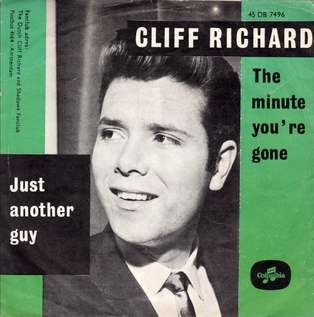Related Research Articles

Johnny Brandon was an English singer and songwriter, popular during the 1950s, who recorded for a number of labels. His perennial backing group was known as The Phantoms. His early hits included "Tomorrow" and "Don't Worry". He also recorded versions of "Slow Poke" and "Painting the Clouds with Sunshine".
"If I Give My Heart to You" is a popular song written by Jimmy Brewster, Jimmie Crane, and Al Jacobs. The most popular versions of the song were recorded by Doris Day and by Denise Lor; both charted in 1954.
The Little Shoemaker" is a popular song based on the French song, "Le petit cordonnier", by Rudi Revil. The original French lyric was written by Francis Lemarque. The English language lyrics were written by Geoffrey Claremont Parsons, Nathan Korb and John Turner.
"Let Me Go, Lover!", a popular song, was written by Jenny Lou Carson and Al Hill, a pen name used by Fred Wise, Kathleen Twomey, and Ben Weisman. It is based on an earlier song called "Let Me Go, Devil", about alcoholism.
"I Believe" is a popular song written by Ervin Drake, Irvin Abraham, Jack Mendelsohn and Al Stillman in 1953. The most popular version was recorded by Italian-American singer Frankie Laine, and spent eighteen weeks at No. 1 on the UK Singles Chart.
"Kewpie Doll" is a 1958 popular song, written by Sid Tepper and Roy C. Bennett. It is based on the popular Kewpie comics characters by Rose O'Neill, who inspired a merchandising phenomenon of dolls and other toys.
"It's Almost Tomorrow" is a 1955 popular song with music by Gene Adkinson and lyrics by Wade Buff. The song was actually written in 1953, when Adkinson and Buff were in high school. Hit versions were released in 1955 by The Dream Weavers, Jo Stafford, David Carroll, and Snooky Lanson.
"(The) Rock and Roll Waltz" is a popular song with music by Shorty Allen and lyrics by Roy Alfred in 1955, although the identity of the lyricist is in dispute. Other sources cite a Dick Ware, Dick Wise, or Dick Wine. The song was notably recorded by Kay Starr.
"Suddenly There's a Valley" is a popular song written by Chuck Meyer and Biff Jones and published in 1955.
"Butterfly" is a popular song written by Bernie Lowe and Kal Mann and published in 1957. The song is credited to Anthony September as songwriter in some sources. This was a pseudonym of Anthony Mammarella, producer of American Bandstand.

Roger John Reginald Greenaway is an English singer, songwriter and record producer, best known for his collaborations with Roger Cook and Tony Burrows. His compositions have included "You've Got Your Troubles" and the transatlantic million selling songs "I'd Like to Teach the World to Sing " and "Long Cool Woman in a Black Dress". They were the first UK songwriting partnership to be granted an Ivor Novello Award as 'Songwriters of the Year' in two successive years.
"In the Chapel in the Moonlight" is a 1936 popular song written by Billy Hill, and first performed by Shep Fields.
"Make It Easy on Yourself" is a popular song written by Burt Bacharach and Hal David which was initially a hit for Jerry Butler in 1962. The best-known version is the 1965 recording by the Walker Brothers, for whom it was a No. 1 UK and Canadian hit. Dionne Warwick, who made a demo of the song in early 1962, later had a hit with it in 1970.
"(Love Is) The Tender Trap" is a popular song composed by Jimmy Van Heusen, with lyrics by Sammy Cahn.
"A Woman in Love" is a popular song. It was written by Frank Loesser and published in 1955. It was introduced in Samuel Goldwyn's 1955 cinematic adaptation of the Broadway musical Guys and Dolls, for which Loesser contributed three new songs – including "A Woman in Love" – which had not been in the original stage production. In the film, it was sung as a duet between Marlon Brando and Jean Simmons. The cover version by Frankie Laine reached number 1 in the UK Singles Chart in 1956.
"Round and Round" is a popular song by Joe Shapiro and Lou Stallman published in 1956. A version of the song was recorded by Perry Como for RCA Victor on January 15, 1957 and was a big hit that year.

"The Minute You're Gone" is a song written by Jimmy Gateley, a Nashville, Tennessee based fiddle player and singer, for Sonny James in 1963. This song originally made No. 95 in the US charts and No. 9 in the country charts for Sonny James in 1963.
"Well I Ask You" is a song written by Les Vandyke and successfully recorded in 1961 by English singer Eden Kane.
"Where Will the Dimple Be?" is a 1955 single by Rosemary Clooney supported by the Buddy Cole Quartet, the Mellomen, and the bass solo of Thurl Ravenscroft, about a pregnant wife speculating where her baby's dimple will be. Clooney recorded the song on January 13, 1955, just weeks before the birth of her son Miguel Ferrer on February 7, 1955. The song was also covered by Alma Cogan and Lorrae Desmond.

"Still" is a 1963 single by Bill Anderson. "Still" was Anderson's second number one on the country chart, staying at the top spot for seven non-consecutive weeks. The song crossed over to the pop chart, peaking at number eight. Anderson performed this song on the finale of the 1977-1978 ABC game show The Better Sex which he co-hosted with Sarah Purcell.
References
- 1 2 Rice, Jo (1982). The Guinness Book of 500 Number One Hits (1st ed.). Enfield, Middlesex: Guinness Superlatives Ltd. p. 18. ISBN 0-85112-250-7.
- ↑ Roberts, David (2006). British Hit Singles & Albums (19th ed.). London: Guinness World Records Limited. pp. 40–1. ISBN 1-904994-10-5.
- ↑ "45cat.com". 45cat.com. Retrieved December 23, 2018.
- ↑ "45cat.com". 45cat.com. Retrieved December 23, 2018.